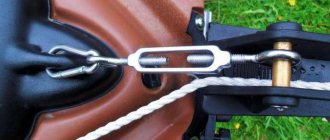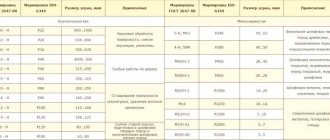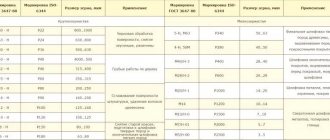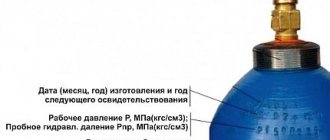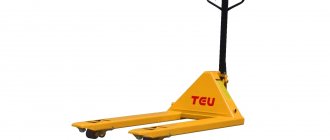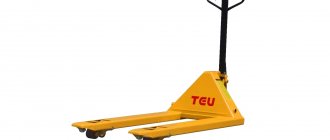Catalog of lanyards DIN 1480
Lanyard DIN 1480 M5
Price - 33.36 for 1 piece (up to 30 thousand rubles)
Hook mouth - 7 mm Weight - 32 g.
Lanyard DIN 1480 M6
Price - 40.20 for 1 piece (up to 30 rub.)
Hook mouth - 8 mm Weight - 51 g.
Lanyard DIN 1480 M8
Price - 54.60 for 1 piece (up to 30 thousand rubles)
Hook mouth - 10 mm Weight - 97 g.
Lanyard DIN 1480 M10
Price - 67.80 for 1 piece (up to 30 thousand rubles)
Hook mouth - 10 mm Weight - 197 g.
Lanyard DIN 1480 M12
Price - 94.56 for 1 piece (up to 30 thousand rubles)
Hook mouth - 12 mm Weight - 314 g.
Lanyard DIN 1480 M14
Price - 143.52 for 1 piece (up to 30 thousand rubles)
Hook mouth - 16 mm Weight - 497 g.
Lanyard DIN 1480 M16
Price - 193.80 for 1 piece (up to 30 thousand rubles)
Hook mouth - 18 mm Weight - 742 g.
Lanyard DIN 1480 M18
Price - 285.80 for 1 piece (up to 30 thousand rubles)
Hook mouth - 18 mm Weight - 1100 g.
Lanyard DIN 1480 M20
Price - 354 rub. for 1 piece (up to 30 tr.)
Hook mouth - 21 mm Weight - 1500 g.
Lanyard DIN 1480 M22
Price - 493.68 for 1 piece (up to 30 thousand rubles)
Hook mouth - 22 mm Weight - 1780 g.
Lanyard DIN 1480 M24
Price - 627.12 for 1 piece (up to 30 thousand rubles)
Hook mouth - 26 mm Weight - 2290 g.
Lanyard DIN 1480 M30
Price - 1067.88 for 1 piece (up to 30 thousand rubles)
Hook mouth - 33 mm Weight - 4600 g.
Lanyard DIN 1480 M32
Price - 1620 rub. for 1 piece (up to 30 tr.)
Hook mouth - 36 mm Weight - 6100 g.
Lanyard DIN 1480 M36
Price - 3720 rub. for 1 piece (up to 30 tr.)
Hook mouth - 44 mm Weight - 7680g.
Operating parameters of lanyards
For the considered devices with couplings, the main operational characteristics are:
- Permissible load.
- The length of the coupling (less commonly, its transverse dimensions).
- The length of the lanyard itself with the claws unscrewed (the threaded part does not come out of the coupling body, but completely fills it).
The standard defines an unambiguous relationship between the diameter of the threaded hole in the turnbuckle coupling and its load-bearing capacity. In particular, for stamped couplings the following relationships exist:
- with a load of up to 200 kg - M8;
- with a load of up to 300 kg - M10;
- with a load of up to 500 kg - M12;
- with a load of up to 1200 kg - M16;
- with a load of up to 2000 kg - M20;
- with a load of up to 3150 kg - M24, etc.
The maximum load-bearing capacity of a standard cargo lanyard with an open coupling is 6300 kg; if higher operational loads are required, the rigging is designed and manufactured according to individual orders. Closed turnbuckles are designed for a load capacity of up to 20,000 kg (with the exception of welded coupling structures, the load on which should not exceed 1,500 kg).
The load-carrying capacity of the lanyard is also determined by the type of cargo grip. The lowest permissible values are for hook-to-hook type grips, and the highest are for fork-fork type grips. The design of all components of the lanyard should not have stress concentrators, therefore, when transitioning from one part of the coupling, fork, hook, etc., the maximum possible radius transitions are provided.
The following mandatory requirements apply to standard lanyard designs:
- Strength category after stamping is not lower than KP25 according to GOST 8479;
- Lock nuts must be manufactured in accordance with GOST 5919 using cold heading methods. Thread grooves are not allowed;
- Metric threads on all parts must comply with the requirements of GOST 24705;
- Cast parts must be free of internal and external macrostructure defects (selective quality control must comply with the requirements of RD 34.17.402);
- Welded versions of couplings are performed using E42A electrodes with mandatory cleaning of finished seams.
- Steel lanyards have a surface anti-corrosion coating.
Catalog of closed fork-fork lanyards
Lanyard closed fork-fork M6
Price - 342 rub. for 1 piece (up to 30 tr.)
Working load - 200 kg Breaking force - 1 ton Weight - 200 g.
Lanyard closed fork-fork M8
Price - 354 rub. for 1 piece (up to 30 tr.)
Working load - 300 kg Breaking force - 1.5 tons Weight - 300 g.
Closed lanyard fork-fork M10
Price - 398.76 rub. for 1 piece (up to 30 tr.)
Working load - 500 kg Breaking force - 2.5 tons Weight - 500 g.
Closed lanyard fork-fork M12
Price - 656.11 rub. for 1 piece (up to 30 tr.)
Working load - 700 kg Breaking force - 3.5 tons Weight - 1000 g.
Closed lanyard fork-fork M16
Price - 852 rub. for 1 piece (up to 30 tr.)
Working load - 1200 kg Breaking force - 6 tons Weight - 1400 g.
Closed lanyard fork-fork M20
Price - 1272.80 rub. for 1 piece (up to 30 tr.)
Working load - 1500 kg Breaking force - 7.5 tons Weight - 2000 g.
Closed lanyard fork-fork M22
Price - 2140.80 rub. for 1 piece (up to 30 tr.)
Working load - 2200 kg Breaking force - 11 tons Weight - 4000 g.
Closed lanyard fork-fork M24
Price - 2188 rub. for 1 piece (up to 30 tr.)
Working load - 5000 kg Breaking force - 25 tons Weight - 5000 g.
Closed lanyard fork-fork M30
Price — 4776 rub. for 1 piece (up to 30 tr.)
Working load - 6200 kg Breaking force - 32 tons Weight - 8000 g.
Closed lanyard fork-fork M36
Price - 9768 rub. for 1 piece (up to 30 tr.)
Working load - 8500 kg Breaking force - 38 tons Weight - 10000 g.
Closed lanyard fork-fork M42
Price - 17551 rub. for 1 piece (up to 30 tr.)
Working load - 10000 kg Breaking force - 50 tons Weight - 12000 g.
Requirements for lanyard parts
GOST 9690-71 provides the following options for the design of turnbuckle couplings:
- Stamped closed couplings.
- Stamped open couplings.
- Cast couplings.
- Welded closed couplings.
- Welded open couplings.
In closed-type turnbuckles, the threaded part of the load element is completely located in the coupling body. This is considered safer, because if the gripping device suddenly breaks (which most often happens along the thread), its remains do not fly apart. Therefore, the maximum permissible tension force for closed lanyards is always greater than for open ones.
The manufacturing technology of the couplings also largely determines the capabilities of the lanyard. Thus, stamped couplings (the blanks for which are high-quality structural steel according to GOST 1050, steel grade 20 and higher) are strong and reliable. This is explained by the fact that the macrostructure of stamped products does not have cut fibers, and, therefore, there are no stress concentrators. The same is typical for cast couplings, however, the structure of the cast metal is coarser-grained, therefore, other things being equal, the body of a cast coupling will break faster than a stamped one.
Welded couplings have the worst load-bearing capacity: in the weld zone, the strength of the metal is reduced by 20...25% (for the same reason, it is strictly forbidden to restore damaged lanyards by welding).
The standard allows two designs of round turnbuckles: with a through hole in the middle of the body, and without it. In the first case, the conditions for rotation of the housing when tightening are improved, but the cross-section of the coupling is weakened. The starting material for such couplings is seamless steel pipes in accordance with GOST 8734 made of steel 25 (in low-critical turnbuckles, duralumin and ordinary quality steel St. 3 in accordance with GOST 380 can also be used).
For the compactness of coupling lanyards, the diameter of the cargo grips is important. In closed couplings it does not exceed M42, otherwise the coupling becomes heavy and difficult to adjust. Open type couplings do not have such restrictions.
Turnbuckle couplings are manufactured for the following types of grips:
- BB (fork-fork).
- VU (fork-ring).
- UU (ring-ring).
- GG (hook-hook).
- VG (fork-hook).
- GU (hook-ring).
Green Pin lanyards with open body and hook-to-hook end caps type G-6313
Lanyards - what are they?
Lanyards are devices whose main purpose is to regulate the tension of a cable or rope. Translated from Dutch, this word means “screed” - this is also often called this product. This fairly simple product consists of three parts: a coupling body (can be open or closed), a head and screws (three different types) with metric counter threads that are screwed into the body on both sides. The position of the screw is fixed at the base of the head using a nut. Lanyards are used during construction and installation work, for securing structures (masts, guy wires), when transporting various cargoes, as well as in many other cases. According to the design of screw heads, there are three main types of products: hook-hook, ring-ring and hook-ring. There are also products with a fork-shaped head - but we do not offer this type.
Lanyard Standards
The DIN 1480 standard products we offer belong to the mounting class; they are not recommended for use for lifting loads - for this purpose, DIN 1478 products belonging to the cargo standard are used. Mounting products are used for fixing structures, loads and for their static fastening, since they are not designed for shock loads when lifting loads.
In marking lanyards, two numbers are often used - one indicates the thread diameter of the product (for example, M16), the other indicates the maximum (breaking) load, in tf, ton-force (older) or Kn, Kilonewton (on newer models).
For example, in the T-30-01 marking, the first number indicates the maximum load - up to 30 kN, or 3 tf. (thread size not shown here).
In the Russian (Soviet) standard for lanyards there is GOST 9690-71. In particular, it defines the following characteristics:
— main parts (head, coupling, axle) are made from grade 25 steel
- the part must be smooth, without burrs and cracks, sharp edges must be rounded
— the anti-corrosion coating must ensure a service life under severe operating conditions (exposure to sea water) for 15 years
— 5% of the products from the batch are tested under double load for 5 minutes.
— ease of rotation should not change during operation or testing
Lanyard sizes
The main existing sizes* are shown in the table:
Empty trash
| Size | Order |
| 5 | |
| 6 | |
| 8 | |
| 10 | |
| 12 | |
| 14 | |
| 16 | |
| 18 | |
| 20 | |
| 22 | |
| 24 | |
| 30 | |
| 32 | |
| 36 |
Dimensions are in accordance with GOST 9690-71. According to the requirements of GOST 3333-55, rubbing parts are coated with graphite lubricant.
Design and principle of operation of the lanyard
The device in question consists of four parts:
- A cast or stamped coupling equipped with two threaded holes. The coupling can be in the form of a rectangular frame or an ellipse.
- Pairs of hooks or other load-handling elements (slings) with threads on the opposite part.
- Washers that distribute the load more evenly.
- Locking nuts that prevent spontaneous rotation of the grips.
A separate group consists of chain lanyards (ratchets), in which the tension occurs not due to the gradual screwing of the grips into the coupling, but due to the twisting of the tension chain located between the load grips. Chain lanyards are used when securing long loads on platforms. It consists of:
- Chains (cable tensioner).
- Two slings.
- The tension mechanism, which, in turn, includes a ratchet and a shaft on which the ratchet wheel is mounted.
In simple designs of chain lanyards, instead of a ratchet, a lever is provided, the rocking movement of which removes slack in the chain tension.
The necessary fixing force is created due to the rotation of the slings. At the same time, the distance between them is reduced, the gaps are selected, and the tension of the held object between the lanyards is ensured.
Coupling turnbuckles are mainly used in pairs, which allows the tension force to be evenly distributed in the branches of the slings. The chain lanyard can be one-sided. The opposite end of such a lanyard is rigidly fixed to the supporting part of the platform. However, in this case, only the axial component of the tension force is perceived, which is why the ratchet cannot be used for lifting loads or holding objects in a vertical position.
